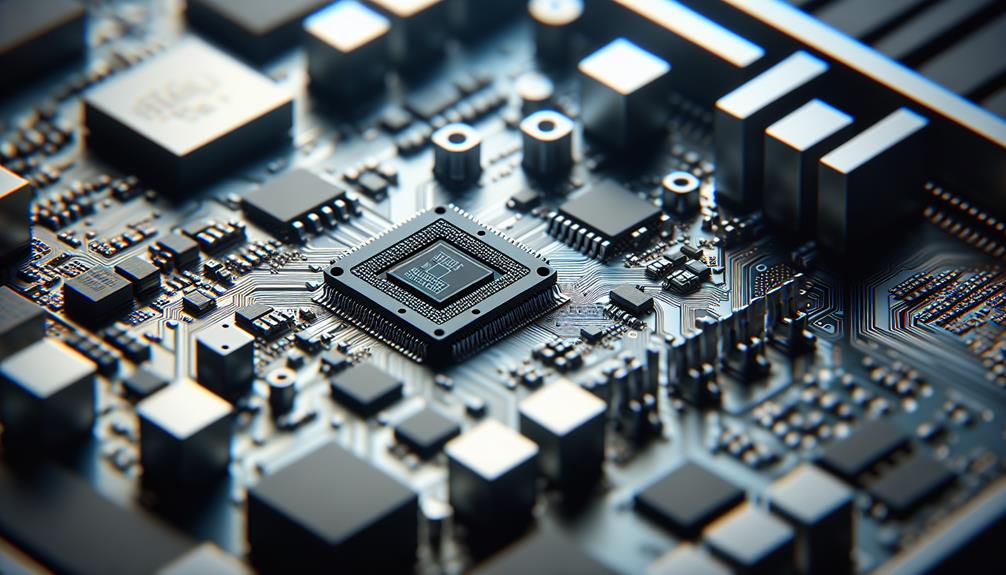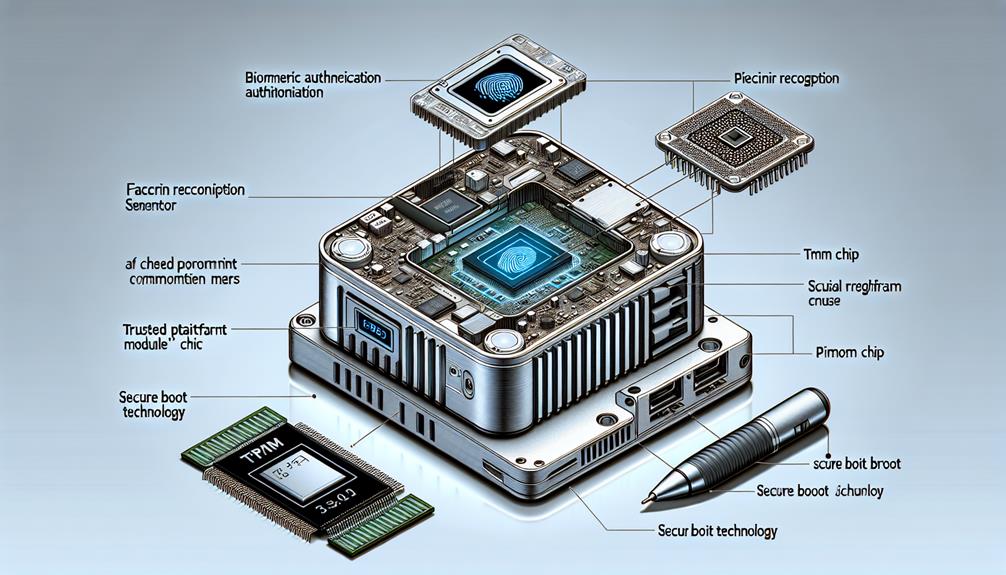



Enhance Mini PCs security with data encryption. Encrypt data for heightened protection; symmetric encryption employs one key, while asymmetric uses key pairs. Advanced algorithms such as AES and RSA bolster defense. Secure Boot is essential; it guarantees boot process integrity and thwarts unsigned code execution. Configure settings to restrict malware threats. Trusted Platform Module (TPM) guarantees secure key management. TPM authenticates, encrypts, and shields data from breaches. BIOS features secure boot process and password protection against unauthorized access. Hardware-based security enfolds secure enclaves and firmware updates for cyber threat defense. Remote management controls access and monitors system metrics for maximum security. Strengthen security by prioritizing these features.
Key Takeaways
- Data Encryption: Utilizes advanced algorithms like AES to protect data from threats.
- Secure Boot Options: Guards against malware by validating firmware integrity during boot.
- Trusted Platform Module (TPM): Hardware-based key management for secure authentication and encryption.
- BIOS Security Measures: Prevent unauthorized access with secure boot mode and password protection.
- Hardware-based Security Features: Secure Enclaves and firmware updates bolster protection against cyber threats.
Data Encryption
To enhance data security on Mini PCs, data encryption plays an important role in safeguarding sensitive information from unauthorized access. Data protection is pivotal in guaranteeing that your data remains confidential and secure. Encryption methods are employed to convert plain text into encoded ciphertext, making it unreadable to anyone without the decryption key.
There are various encryption methods used in Mini PCs to secure data. One common method is symmetric encryption, where the same key is used for both encryption and decryption. Asymmetric encryption, on the other hand, uses a pair of keys – a public key for encryption and a private key for decryption. This method enhances security by allowing secure communication between parties without sharing the private key.
Additionally, Mini PCs may utilize advanced encryption algorithms such as AES (Advanced Encryption Standard) or RSA (Rivest-Shamir-Adleman) to protect data at rest and in transit. These robust encryption methods ensure that your sensitive information remains safe from potential threats.
Secure Boot Options
Data encryption acts as a foundational security measure on Mini PCs, while another critical aspect to consider is the implementation of Secure Boot Options. Secure Boot is a feature that guarantees the integrity of the boot process by only permitting the loading of firmware and drivers that are signed with trusted certificates. To enhance security, it is crucial to configure the secure boot settings properly. These settings are typically found in the BIOS or UEFI firmware of the Mini PC.
When setting up Secure Boot, you can opt to enable options such as restricting the execution of unsigned code, enabling validation of firmware, and controlling the loading of drivers during the boot process. By configuring these secure boot settings effectively, you can strengthen the protection of your Mini PC against malware and unauthorized software modifications. Additionally, Secure Boot helps in safeguarding the firmware of the device, providing an added layer of defense against potential attacks targeting the boot process. Properly configuring Secure Boot contributes significantly to the overall firmware protection of Mini PCs.
Trusted Platform Module (TPM)

An important element to contemplate for improving the security features of Mini PCs is the Trusted Platform Module (TPM), which plays a vital role in safeguarding sensitive information and guaranteeing the integrity of system processes. TPM is a hardware-based security feature that provides secure key management, allowing for the generation, storage, and protection of cryptographic keys. These keys are used to authenticate and encrypt data, preventing unauthorized access and preserving the confidentiality of information stored on the Mini PC.
Furthermore, TPM facilitates secure firmware updates by verifying the integrity of the firmware before allowing any modifications to take place. This ensures that only authorized updates from trusted sources are applied, reducing the risk of malware injections or other unauthorized changes to the system. By utilizing TPM for secure key management and firmware updates, Mini PCs can enhance their overall security posture, protecting against potential threats and vulnerabilities that may compromise the system's integrity.
BIOS Security Measures
Implementing robust BIOS security measures is essential for fortifying the overall security framework of Mini PCs, ensuring protection against unauthorized access and potential cyber threats. One key BIOS security measure is the secure boot process, which verifies the integrity of the system firmware and essential software components during startup. This process helps prevent malware from tampering with the boot sequence, ensuring that only trusted code is executed.
To enhance BIOS security, Mini PCs often utilize features like secure boot mode, which only allows digitally signed firmware and operating system components to run. This helps safeguard against malicious software that may attempt to exploit vulnerabilities in the boot process. Additionally, BIOS security measures include password protection to restrict unauthorized access to BIOS settings, reducing the risk of configuration tampering by unauthorized users.
Furthermore, Mini PCs may incorporate malware protection mechanisms within the BIOS to detect and prevent malicious code from compromising the system. These vital security measures play an important role in mitigating potential threats and ensuring the integrity of the Mini PC's operations.
Hardware-based Security Features

Utilizing hardware-based security features enhances the strength of Mini PCs' defense mechanisms against potential cyber threats and unauthorized access attempts. Secure Enclaves are an important hardware-based security feature in Mini PCs. These isolated execution environments provide a secure space for sensitive operations, such as storing encryption keys and performing secure transactions. By utilizing Secure Enclaves, Mini PCs can protect critical data from malicious attacks, safeguarding the confidentiality and integrity of information.
Firmware Updates are another essential hardware-based security feature. Regularly updating the firmware of a Mini PC helps to patch known vulnerabilities, strengthen security protocols, and improve overall system resilience. These updates not only enhance security but also guarantee that the Mini PC's hardware components operate efficiently and reliably.
Incorporating hardware-based security features like Secure Enclaves and prioritizing Firmware Updates are fundamental steps in fortifying the security posture of Mini PCs, safeguarding them against evolving cyber threats and potential exploits.
Remote Management and Monitoring
Enhancing the security of Mini PCs involves establishing robust systems for remote management and monitoring. Remote access control plays an important role in guaranteeing that only authorized users can access the Mini PC remotely. By implementing secure authentication methods such as two-factor authentication and encryption protocols, you can prevent unauthorized access to the system.
Moreover, remote management tools enable you to monitor the Mini PC's performance and address any potential security threats promptly. Through real-time monitoring of system metrics like CPU usage, memory utilization, and network activity, you can detect anomalies that may indicate a security breach. This proactive approach allows you to take immediate action to safeguard the Mini PC and its data.
Additionally, system performance optimization is a key aspect of remote management and monitoring. By analyzing performance data collected remotely, you can identify bottlenecks, resource constraints, or software issues that may impact the Mini PC's security and overall efficiency. Implementing performance tuning strategies based on these insights can help enhance the Mini PC's security posture and ensure smooth operation.
Disclosure: As an Amazon Associate, I earn from qualifying purchases.



